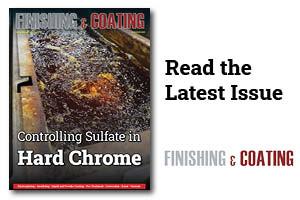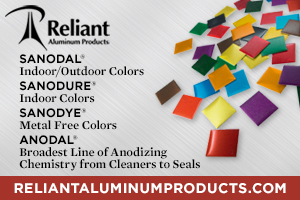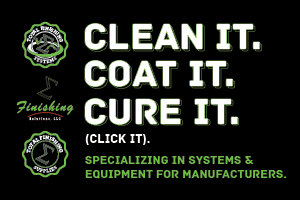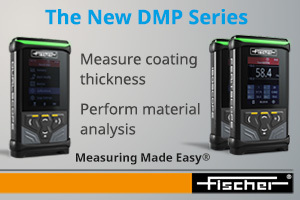A company utilized outside sources for electroless nickel deposits over copper substrates in an electronic application that required the EN coating to be solderable without the use of any flux.
 Frank AltmayerSoldering was performed in a conveyorized furnace under nitrogen-hydrogen atmosphere, at a temperature range up to approximately 250°C. The purpose of hydrogen is to reduce surface oxides, which inhibit solderability, while nitrogen serves as an inert dilution gas to maintain preset hydrogen levels.
Frank AltmayerSoldering was performed in a conveyorized furnace under nitrogen-hydrogen atmosphere, at a temperature range up to approximately 250°C. The purpose of hydrogen is to reduce surface oxides, which inhibit solderability, while nitrogen serves as an inert dilution gas to maintain preset hydrogen levels.
Three types of components are soldered onto the surface of the EN using no flux and “preforms” of solder. The solder preforms are die-cut and set onto the surface of the heat sink. The assembly then enters the heated zone of the furnace, where the temperature is ramped up in a controlled manner until the solder melts. Soldered components are tested for adhesive strength by applying a shear force to the base of the soldered component. Poor solder joint strength results in the soldered component being pushed off the electroless nickel surface.
The company has been experiencing erratic results and wanted help on what they could have the vendor change to improve the solderability of the electroless nickel. The coating they are currently specifying is a mid-phos, 7% to 9% deposit.
I discussed with them the option of using a lower-phosphorus nickel, but that would require a specification change, so it is not a viable, quick alternative. A lower phosphorus content electroless deposit would provide some benefit, however, because the long-term solderability of the deposit diminishes with increased phosphorus content.
Our investigation determined the following causes and remedies to the problem of solderability. The following list is provided, with the most important cause covered first; however, the relative importance of the second and third must be established through further testing and evaluation.
Surface Condition of the EN Deposit
Plated parts were successfully soldered when the parts were less than 24 hours old. The solderability of freshly deposited EN is reduced significantly by aging and/or the presence of surface impurities. As the electroless nickel ages, it reacts with oxygen in the air, forming nickel oxide. It can also react with other elements in the atmosphere, especially sulfur (from paper, or naturally present in the air), to form stable nickel compounds (nickel sulfide in the case of sulfur contamination). It is the presence or absence of dense oxides/sulfides that results in poor solderability.
The problem is exacerbated by the presence of impurities in the EN deposit, which results from poor filtration practices on the part of the plater and a lack of control over the operating parameters of the electroless process, including the level of impurities present in the plating solution.
The maximum level of commonly encountered impurities must be maintained as follows:
- Impurity: Maximum ppm
- Lead: 5
- Cadmium: 5
- Iron: 150
- Aluminum: 300
- Palladium: 3
- Cr+3: 15
- Cr+6: 3
- NO3: 50
- H3PO3: 150
The soldering furnace utilizes hydrogen gas to reduce oxides from the surface of the electroless nickel before soldering. Solderability may be affected by the furnace conditions as follows:
- The hydrogen they use is “dry,” while humidified hydrogen is considered to be more effective in reducing oxides.
- In their soldering operation, the hydrogen gas concentration is lowest when it is most needed. The gas concentration is 26–31 percent when the solder first enters the furnace, up until it is theoretically at a “pasty” condition (before melting). Based on the temperature profile we were provided, once the solder has melted, the hydrogen gas concentration exceeds 50%. At this point, it is effectively not needed because the solder has already melted. If possible, reprogram the soldering operation to have the higher hydrogen concentration before the solder melts.
It is our opinion that the furnace is fully capable of successfully soldering EN deposits that are relatively “fresh.” Still, we suspect that any EN that has aged significantly — or has reacted with sulfur — does not solder well under these conditions.
Solder Quality
Our on-site investigation revealed a significant variation in the quality of the solder preforms. The surface of some of the dewetted solder turned a golden-orange in color, and it appeared that the degree of discoloration was directly related to the degree of dewetting observed. Furnace operators reported that changing the preform solder reel often resolved a soldering issue, suggesting that variations in solder preform quality may be related to the problem.
Our recommendations to achieve a high level of solderability in this manufacturing operation follow:
- The electroless plating processes require modification and better control.
- The packaging of plated parts needs to be revised to prevent the electroless nickel from being stored under humid or corrosive conditions.
- The time between plating and soldering parts needs to be reduced as much as possible.
- The solder preforms must be of consistent quality.
- The soldering furnace may need to be optimized beyond its current conditions if the above changes do not resolve the issue.
Frank Altmayer is a Master Surface Finisher, an AESF Fellow, and the technical education director of the AESF Foundation and NASF. He owned Scientific Control Laboratories from 1986 to 2007 and has over 50 years of experience in the metal finishing industry. He received the AESF Past Presidents Award, the NAMF Award of Special Recognition, the AESF Leadership Award, the AESF Fellowship Award, the Chicago Branch AESF Geldzahler Service Award, and the NASF Award of Special Recognition.



































